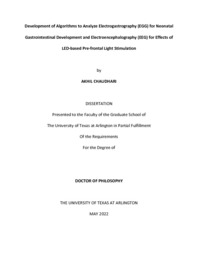| dc.contributor.advisor | Liu, Hanli | |
| dc.creator | Chaudhari, Akhil Mahendra M | |
| dc.date.accessioned | 2023-06-28T15:46:08Z | |
| dc.date.available | 2023-06-28T15:46:08Z | |
| dc.date.created | 2022-05 | |
| dc.date.issued | 2022-05-17 | |
| dc.date.submitted | May 2022 | |
| dc.identifier.uri | http://hdl.handle.net/10106/31395 | |
| dc.description.abstract | Algorithm development, and biological signal processing are the key components for new applications of successful medical diagnosis that can provide physiological and functional information to better understand human condition for either patients with certain diseases or healthy human beings. Neuroimaging tools, such as functional near infrared spectroscopy (fNIRS), and electrogastrography (EGG) have been used to investigate the gut maturity in diseased and healthy state; and electroencephalogram (EEG) have been used to investigate brain functions in response to neuromodulated or task-based interventions. Accordingly, my dissertation focused on algorithm development and signal processing for two major topics: (1) to outline EGG response to gastrointestinal maturity in preterm, term neonates under different feeding intervention conditions. (2) to map electrophysiological responses in healthy human brain in response to transcranial photobiomodulation (tPBM) using Light Emitting Diode (LED). Furthermore, LED-tPBM is an important neuromodulation tool for treating several neurological disorders, as well for enhancement of cognition, hence it is essential to monitor electrophysiological changes induced by LED-tPBM on healthy human head.
Enteral feeding can be challenging in preterm neonates because of gastrointestinal (GI) immaturity leading to feeding intolerance. Current techniques to monitor feeding intolerance are non-specific and poor predictors of GI maturity and feeding readiness. Objective measures of GI maturity are needed for accurate assessment of feeding readiness. Electrogastrography (EGG) is a non-invasive technology that can be used to measure gastric myoelectrical activity in neonates of different gestational ages (GA). Hence in this aim we characterized different parameters of gastric myoelectrical activity such as mean power spectral density, % time in bradygastria, % time in normogastria, and % time in tachygastria by EGG in neonates of different GA before, during and post feeding.
Transcranial photobiomodulation (tPBM) is a novel optical neuromodulation method that uses lasers or light emitting diodes (LED) to improve human cognitive functions for various brain disorders in the human brain. However, there is a lack of investigations on the improvement of cognitive and electro-physiological functions in the healthy human brains. This work addresses the knowledge gap of electro-physiological responses while performing a vigilance based task induced by LED-based tPBM in healthy human head.
Specifically, chapter 2 depicts the characterization of different parameters of gastric myoelectrical activity by EGG in neonates of different GA before, during and post feeding. The EGG signals were analyzed for respective mean Power spectral density (PSD) at the three gastric rhythms (GR; i.e. bradygastria (0.5-2 cpm), normogastria (2-4 cpm), tachygastria (4-9 cpm)). These results suggest that feeding dependent mean PSD values in normogastria (2-4 cpm) and tachygastria (4-9 cpm) increased significantly with increase of GA. The percent time spent in normogastria was also found to increase with increased GA.
In Chapter 3, the effects of tPBM applied on right forehead is investigated while performing vigilance based task (PVT) as measured by EEG. To help understand the eletro-physiological changes induced by LED-based tPBM, acute changes in power in scalp were quantified. These findings imply that LED-based stimulation for ten minutes significantly affect brain activity. The Delta (0.5-4 Hz) and alpha (7-13 Hz) band power significantly increased under LED stimulation while performing PVT task. Further EEG power at the temporal lobe and motor regions was found to increase in delta band, and parieto-occipital, left-temporal lobes in the healthy human brain.
Chapter 4 further expands on the effect of LED-based stimulation on reaction time and electro-physiological changes induced by four weeks of stimulation. To help understand the effect of LED-based stimulation on reaction time, the reaction time was compared across time (weeks) for both LED and sham treated groups. The electro-physiological changes after four weeks of LED-based stimulation were quantified by comparing the power changes across four weeks for both LED and sham treated groups. Further source localization was performed to identify the brain networks activated under LED-based stimulation. These findings suggests that reaction time significantly decreases over four weeks suggesting improvement in vigilance. The Power in Theta (4-7 Hz), Beta (13-30 Hz), and Gamma (30-70 Hz) frequency bands significantly increases after four weeks under LED-based stimulation. Furthermore, power increment was also found in default mode network, executive control network, fronto-parietal network, and visual network. These results may help understand the underlying mechanisms of LED-based tPBM modulated brain networks while performing vigilance tasks. | |
| dc.format.mimetype | application/pdf | |
| dc.language.iso | en_US | |
| dc.subject | Functional near infrared spectroscopy (fNIRS) | |
| dc.subject | Electrogastrography (EGG) | |
| dc.subject | Electroencephalogram (EEG) | |
| dc.subject | Neuromodulation | |
| dc.subject | Transcranial photobiomodulation (tPBM) | |
| dc.subject | Light emitting diode (LED) | |
| dc.subject | Gastrointestinal (GI) | |
| dc.subject | Gestational age (GA), Bradygastria | |
| dc.subject | Normogastria | |
| dc.subject | Tachygastria | |
| dc.subject | Power spectral density (PSD) | |
| dc.subject | Vigilance based task (PVT) | |
| dc.subject | Vigilance | |
| dc.subject | Electro-physiological | |
| dc.subject | Default mode network | |
| dc.subject | Executive control Network | |
| dc.subject | Fronto-Parietal Network | |
| dc.subject | Visual Network | |
| dc.title | Development of Algorithms to Analyze Electrogastrography (EGG) for Neonatal Gastrointestinal Development and Electroencephalography (EEG) for Effects of LED-based Pre-frontal Light Stimulation | |
| dc.type | Thesis | |
| dc.date.updated | 2023-06-28T15:46:09Z | |
| thesis.degree.department | Bioengineering | |
| thesis.degree.grantor | The University of Texas at Arlington | |
| thesis.degree.level | Doctoral | |
| thesis.degree.name | Doctor of Philosophy in Biomedical Engineering | |
| dc.type.material | text | |
| dc.creator.orcid | 0000-0003-0990-8210 | |


